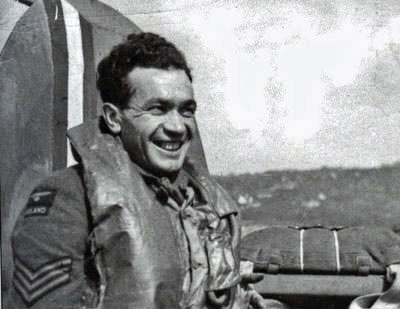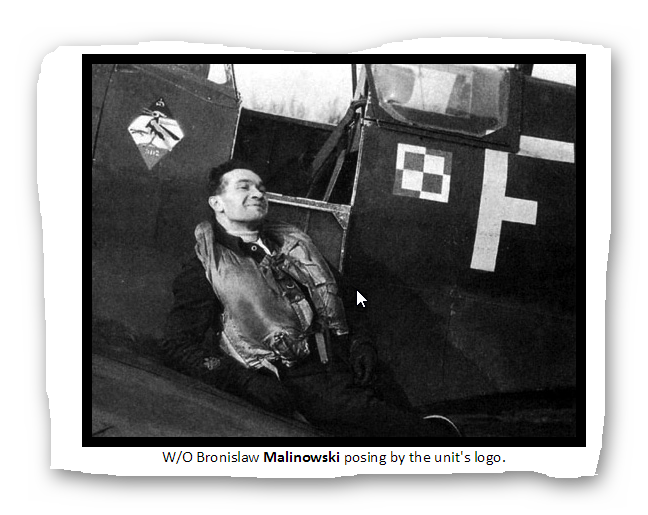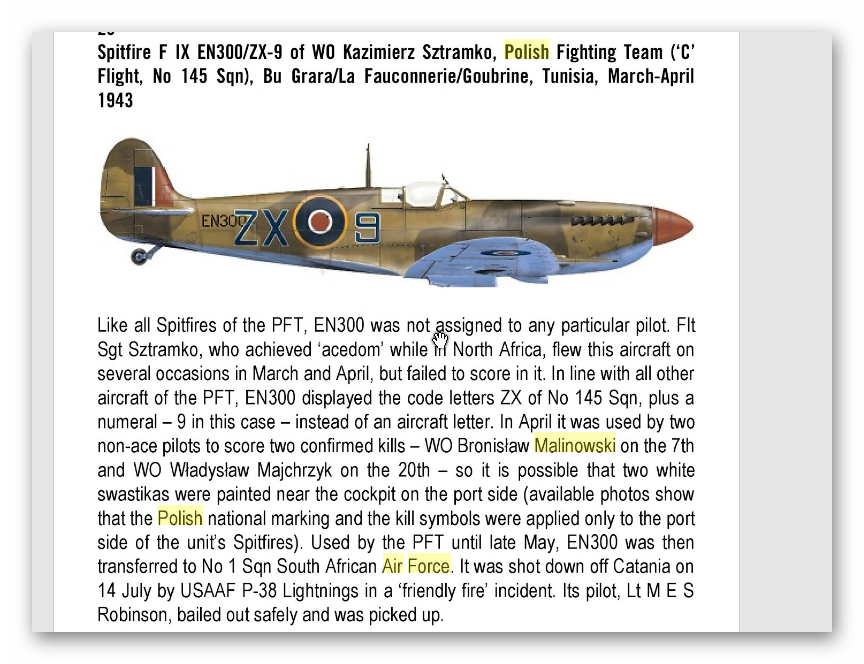MALINOWSKI, Bronislaw
Stats:
rank: F/Lstatus: survived
airforce: RAF (no: 782059 )
born: 1921-02-12 Lviv Poland
added by: Red Dragon
Bio / Text:
I would like to comment, that the story of the rescue of Bronislaw Malinowski after 8 September 1943 is full of gaps, half truths and mistakes. I can supply much better information, if you are interested. F/Sgt Malinowski was a very brave man, no doubt about that!
Bronislaw Malinowski was born on 12th February 1912 in Lviv, Poland.
In 1929 he joined 6 Aviation Regiment in Lviv and was sent the following year to the flying school at Bydgoszcz with further training at Grudziadz . He then he served as a fighter pilot in the 3rd Aviation Regiment in Poznan. In 1934 he was posted as an instructor to the Aviation Academy at Deblin and was still there in September 1939.
He flew with the scratch detatchment of instructors defending Deblin in obsolete PZL P7 aircraft before escaping via Romania, Yugoslavia and Greece to France.
Malinowski was posted to a ferry unit on 13th May 1940 but with the deteriorating situation he flew on 23rd June from Marseilles to Casablanca in a twin-engine LeO 451. He then went by ship via Gibraltar to England, arriving on 13th July 1940. He was sent to the Polish Wing at 3 School of Technical Training Blackpool, to await a posting.
Malinowski was posted to 307 Squadron at Kirton-in-Lindsey on 10th September. The squadron was intended to be the first Polish night-fighter squadron but training ceased when the pilots were posted away to fill gaps at day-fighter squadrons.
Malinowski went to No. 1 School of Army Co-operation Old Sarum for the 8th Polish Pilots Course from 9th to 16th October 1940 for testing and grading. He then went to 5 OTU Aston Down, converted to Hurricanes and joined 43 Squadron at Usworth on 25th October 1940.
On the 31st he was flying with Green section of 43 Squadron which was vectored to investigate an X-raid over the sea. His engine started misfiring but he was able to reach land and make a forced landing near Havelow Farm at Chirnside, west of Berwick.
In early December he was posted to 501 Squadron at Kenley. On 11th April 1941 he joined 302 Squadron at Westhampnett. Malinowski probably destroyed a Me109 on 30th December 1941.
He was awarded the KW (gazetted 20th February 1942) and with his tour completed he went to 58 OTU Grangemouth on 6th May as an instructor.
Malinowski returned to 302 Squadron, then at Heston, on 10th November 1942. He went to West Kirby on 13th February 1943 to prepare for overseas service and on 13th March he arrived in the Middle East in a C-47 with other Polish pilots to form the Polish Fighting Team, otherwise known as Skalski’s Circus.
They were attached to 145 Squadron and operated in the Western Desert from 17th March to 12th May and destroyed 30 enemy aircraft. Malinowski destroyed a Me109 on 7th April.
Back in the UK, he rejoined 302 Squadron on 22nd July 1943. Over France on 8th September he destroyed two Me109's but his Spitfire V AA928/WX-U was shot down with Malinowski receiving leg injuries.
He evaded capture and with assistance from the local resistance he was hidden in the morgue of the hospital at Ypres where he underwent surgery for his wounds. The resistance passed him to Spain and on 13th December 1943 he returned to Britain and 302 Squadron. MI9 Report no 3317/1640.
Despite injuries (shrapnel in his right leg and burns after the oxygen tank explosion) he managed to get himself out of the plane. He found hidden in a nearby vineyard, whose owner accidentally found Malinowski began to provide him with water and food. The pilot waited for the raid, and on the fifth day he was contacted by Belgian, who arranged for him to transport to another farm. The doctor was also invited to take care of the wounded. Because of the inability to remove leg shards, Malinowski was taken to a hospital run by a nurse at Ypres, however, due to the presence of a German hospital wounded soldiers were placed in a hospital morgue. There, without anesthesia, he had undergone surgery to remove the debris and waited until his condition improved enough to leave the hospital. After about three weeks, he was taken by two men to Langemark where he received a false identity card and then taken to Liege. There, two other Belgians were contacted by him, who contacted him with resistance. The underground organized for him a trip to Spain - Malinowski performed as a veterinarian, which was a good disguise for horses and cattle epidemics. Traveling through Brussels and Paris successfully reached the border and after crossing the Pyrenees he found himself in Spain. After further journeys, he checked in at the British embassy in Madrid, where he had no trouble leaving for Gibraltar by car, arriving in England on December 23, 1943, arriving at Portreath.
He was awarded two Bars to the KW (gazetted 20th December 1943).
On 25th March 1944 Malinowski went to No. 1 ADU Croydon, returning to 302 Squadron, then at Chailey, on 29th June. He was awarded the DFC (gazetted 25th September 1944), the VM (5th Class) (gazetted 25th September 1944) and a third Bar to the KW (gazetted 30th December 1944) and the C de G (Fr).
30 July 1944, during the bombing of German groupings in the area of Falaise's boiler, his Spitfire MJ359 was hit by anti-aircraft artillery fire. Malinowski tried to pull the sliding line to the Allied line, but he did not have enough height and had to land in the field, no man's land. At landing, he intentionally hooked his wing to the tree to brake the plane and avoid breaking up. At the touchdown, the engine was dented deep into the cockpit, and both pilot legs were broken and jammed in the wreck. Spitfire Malinowski pulled out and took Canadian tanks to the field hospital. Later he was transported to a hospital in England, where he spent many months following treatment and rehabilitation.
He joined 133 Wing on the Continent on 18th March 1945. He was commissioned from Warrant Officer in June 1945 and was released from the Polish Air Force in January 1947 as a Flight Lieutenant.
After the war he served with the Royal Pakistani Air Force. For a while he commanded the navigation training section at the RPAF College Risalpur.
Flt Lt Malinowski was known to have flown the following Spitfire aircraft during his career.
302 Squadron
30/12/41 AA572 WX-W
30/7/44 MJ354
8/9/44 AA928 WX-U
Polish Fighting Team
4/7/43 EN300 ZX-9
Upon return to Britain he ran a garage and then a pub.
On his own he also began to search for Belgians who helped him avoid captivity years ago. It was not until 1974 that he learned who his carers were, and on 9 May 1976 his meetings with the inhabitants of Madonna, Poelkapelle and Lengemark came from Belgian patriots. During the ceremony Madonna was revealed to the memory of four Belgians who were sent to the concentration camp for hiding the aviator and died (for reporting the whereabouts of the shotgun pilot, the German occupation authorities designated a cash prize of 500,000 francs). Their names are Michel Buyse, Adolf Coryn, Jules Opsomer and Art Verhoustraete. Michel Salomez, Arthur Heart, Michel van Gheluwe, H. Platteu, C. van Neste and Dr Dehaene and Dr Ronse, as well as many Belgians from Comet and the Tango ".
He died on 1st May 1982 in London. After the cremation his ashes were brought to Poland and deposited in the municipal cemetery in Ksawerowo.
Ref
Battle of Britain Monument
polishairforce.pl
Bronislaw Malinowski was born on 12th February 1912 in Lviv, Poland.
In 1929 he joined 6 Aviation Regiment in Lviv and was sent the following year to the flying school at Bydgoszcz with further training at Grudziadz . He then he served as a fighter pilot in the 3rd Aviation Regiment in Poznan. In 1934 he was posted as an instructor to the Aviation Academy at Deblin and was still there in September 1939.
He flew with the scratch detatchment of instructors defending Deblin in obsolete PZL P7 aircraft before escaping via Romania, Yugoslavia and Greece to France.
Malinowski was posted to a ferry unit on 13th May 1940 but with the deteriorating situation he flew on 23rd June from Marseilles to Casablanca in a twin-engine LeO 451. He then went by ship via Gibraltar to England, arriving on 13th July 1940. He was sent to the Polish Wing at 3 School of Technical Training Blackpool, to await a posting.
Malinowski was posted to 307 Squadron at Kirton-in-Lindsey on 10th September. The squadron was intended to be the first Polish night-fighter squadron but training ceased when the pilots were posted away to fill gaps at day-fighter squadrons.
Malinowski went to No. 1 School of Army Co-operation Old Sarum for the 8th Polish Pilots Course from 9th to 16th October 1940 for testing and grading. He then went to 5 OTU Aston Down, converted to Hurricanes and joined 43 Squadron at Usworth on 25th October 1940.
On the 31st he was flying with Green section of 43 Squadron which was vectored to investigate an X-raid over the sea. His engine started misfiring but he was able to reach land and make a forced landing near Havelow Farm at Chirnside, west of Berwick.
In early December he was posted to 501 Squadron at Kenley. On 11th April 1941 he joined 302 Squadron at Westhampnett. Malinowski probably destroyed a Me109 on 30th December 1941.
He was awarded the KW (gazetted 20th February 1942) and with his tour completed he went to 58 OTU Grangemouth on 6th May as an instructor.
Malinowski returned to 302 Squadron, then at Heston, on 10th November 1942. He went to West Kirby on 13th February 1943 to prepare for overseas service and on 13th March he arrived in the Middle East in a C-47 with other Polish pilots to form the Polish Fighting Team, otherwise known as Skalski’s Circus.
They were attached to 145 Squadron and operated in the Western Desert from 17th March to 12th May and destroyed 30 enemy aircraft. Malinowski destroyed a Me109 on 7th April.
Back in the UK, he rejoined 302 Squadron on 22nd July 1943. Over France on 8th September he destroyed two Me109's but his Spitfire V AA928/WX-U was shot down with Malinowski receiving leg injuries.
He evaded capture and with assistance from the local resistance he was hidden in the morgue of the hospital at Ypres where he underwent surgery for his wounds. The resistance passed him to Spain and on 13th December 1943 he returned to Britain and 302 Squadron. MI9 Report no 3317/1640.
Despite injuries (shrapnel in his right leg and burns after the oxygen tank explosion) he managed to get himself out of the plane. He found hidden in a nearby vineyard, whose owner accidentally found Malinowski began to provide him with water and food. The pilot waited for the raid, and on the fifth day he was contacted by Belgian, who arranged for him to transport to another farm. The doctor was also invited to take care of the wounded. Because of the inability to remove leg shards, Malinowski was taken to a hospital run by a nurse at Ypres, however, due to the presence of a German hospital wounded soldiers were placed in a hospital morgue. There, without anesthesia, he had undergone surgery to remove the debris and waited until his condition improved enough to leave the hospital. After about three weeks, he was taken by two men to Langemark where he received a false identity card and then taken to Liege. There, two other Belgians were contacted by him, who contacted him with resistance. The underground organized for him a trip to Spain - Malinowski performed as a veterinarian, which was a good disguise for horses and cattle epidemics. Traveling through Brussels and Paris successfully reached the border and after crossing the Pyrenees he found himself in Spain. After further journeys, he checked in at the British embassy in Madrid, where he had no trouble leaving for Gibraltar by car, arriving in England on December 23, 1943, arriving at Portreath.
He was awarded two Bars to the KW (gazetted 20th December 1943).
On 25th March 1944 Malinowski went to No. 1 ADU Croydon, returning to 302 Squadron, then at Chailey, on 29th June. He was awarded the DFC (gazetted 25th September 1944), the VM (5th Class) (gazetted 25th September 1944) and a third Bar to the KW (gazetted 30th December 1944) and the C de G (Fr).
30 July 1944, during the bombing of German groupings in the area of Falaise's boiler, his Spitfire MJ359 was hit by anti-aircraft artillery fire. Malinowski tried to pull the sliding line to the Allied line, but he did not have enough height and had to land in the field, no man's land. At landing, he intentionally hooked his wing to the tree to brake the plane and avoid breaking up. At the touchdown, the engine was dented deep into the cockpit, and both pilot legs were broken and jammed in the wreck. Spitfire Malinowski pulled out and took Canadian tanks to the field hospital. Later he was transported to a hospital in England, where he spent many months following treatment and rehabilitation.
He joined 133 Wing on the Continent on 18th March 1945. He was commissioned from Warrant Officer in June 1945 and was released from the Polish Air Force in January 1947 as a Flight Lieutenant.
After the war he served with the Royal Pakistani Air Force. For a while he commanded the navigation training section at the RPAF College Risalpur.
Flt Lt Malinowski was known to have flown the following Spitfire aircraft during his career.
302 Squadron
30/12/41 AA572 WX-W
30/7/44 MJ354
8/9/44 AA928 WX-U
Polish Fighting Team
4/7/43 EN300 ZX-9
Upon return to Britain he ran a garage and then a pub.
On his own he also began to search for Belgians who helped him avoid captivity years ago. It was not until 1974 that he learned who his carers were, and on 9 May 1976 his meetings with the inhabitants of Madonna, Poelkapelle and Lengemark came from Belgian patriots. During the ceremony Madonna was revealed to the memory of four Belgians who were sent to the concentration camp for hiding the aviator and died (for reporting the whereabouts of the shotgun pilot, the German occupation authorities designated a cash prize of 500,000 francs). Their names are Michel Buyse, Adolf Coryn, Jules Opsomer and Art Verhoustraete. Michel Salomez, Arthur Heart, Michel van Gheluwe, H. Platteu, C. van Neste and Dr Dehaene and Dr Ronse, as well as many Belgians from Comet and the Tango ".
He died on 1st May 1982 in London. After the cremation his ashes were brought to Poland and deposited in the municipal cemetery in Ksawerowo.
Ref
Battle of Britain Monument
polishairforce.pl
Squadrons:
| Squadrons add | |||
|---|---|---|---|
| Airforce | Sqdrn | Start | Finish |
| RAF | Polish wing No3 SofTT Blackpool | -- | |
| RAF | 307 Kirton-in-Lindsay | 1940-09-10 | -- |
| RAF | No1 School of Army Co-operation Old Sarum | 1940-10-09 | -- |
| RAF | 5 OTU Aston Down | -- | |
| RAF | 43 Usworth | 1940-10-25 | -- |
| RAF | 501 Kenley (12/40) | -- | |
| RAF | 302 Westhamptnett | 1941-04-11 | -- |
| RAF | Instructor 58 OTU Grangemouth | 1942-05-06 | -- |
| RAF | 302 Heston | 1942-11-10 | -- |
| RAF | Polish Fighting Team (Attached145 ) | 1943-03-17 | -- |
| RAF | 302 Perranporth | 1943-07-22 | -- |
| RAF | No1 ADU Croydon | 1944-03-25 | -- |
| RAF | 302 Chailey | 1944-06-29 | -- |
| RAF | 133 Wing Europe | 1945-03-18 | -- |
post
Comments / Questions:
post





